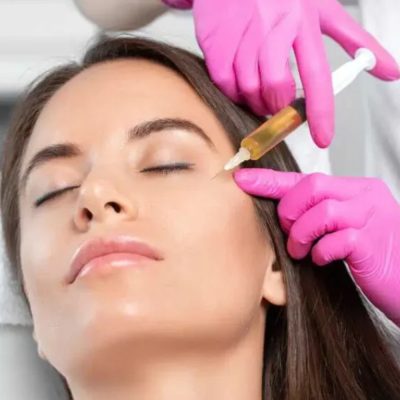Facial Platelet-Rich Plasma (PRP) Therapy
Facial platelet-rich plasma (PRP) therapy is an advanced, non-surgical cosmetic treatment that leverages the body’s natural healing abilities to rejuvenate the skin. Using the patient’s own blood, PRP stimulates collagen production, promotes cell regeneration, and enhances the overall texture and tone of the skin. This minimally invasive procedure has gained popularity for its ability to deliver natural-looking, radiant skin with minimal downtime.

What is Facial PRP Therapy?
Facial PRP therapy is also often called ‘Vampire Facial’. It involves extracting a small amount of the patient’s blood, processing it to concentrate the platelets and then re-injecting the platelet-rich plasma into the skin. Platelets are rich in growth factors that promote healing and regeneration, making PRP an effective treatment for improving skin texture, reducing fine lines, and enhancing overall skin tone. Facial PRP is ideal for individuals seeking a natural, rejuvenating treatment without the use of synthetic products or surgery.
Method & Treatment of Facial PRP Therapy
How Facial PRP Works
The key to facial PRP lies in the growth factors contained within the platelets. When injected into the skin, PRP stimulates collagen production and accelerates tissue repair, leading to improved skin texture and elasticity.
Treatment Procedure
Consultation & Assessment
A detailed consultation is conducted to evaluate the patient’s skin concerns and determine if facial PRP is suitable.
Blood Draw & PRP Preparation
A small amount of blood is drawn from the patient’s arm and placed in a centrifuge. The centrifuge spins at a high rate, separating the platelet-rich plasma from the other components of the blood.
PRP Application
The PRP is either injected into the skin using fine needles or applied topically in conjunction with microneedling. This allows the growth factors to penetrate deeper into the skin.
Post-Treatment Care
After the procedure, patients are advised on aftercare to ensure optimal healing and results.
Applied Areas of Facial PRP
Facial PRP can be used to target various areas of the face and neck, offering a versatile approach to skin rejuvenation:
Fine Lines & Wrinkles
To reduce the appearance of fine lines around the eyes, mouth, and forehead.
Acne Scars & Skin Texture
To improve the appearance of acne scars and enhance overall skin texture.
Under-Eye Area
To address dark circles, puffiness, and fine lines under the eyes.
Neck & Décolletage
To tighten and rejuvenate the skin on the neck and chest.
Precautions and Risks of Facial PRP
While facial PRP is generally safe and well-tolerated, it’s important to be aware of the following precautions and risks:
- A thorough consultation with a qualified dermatologist is essential to assess the patient’s skin type and medical history.
- Patients with blood disorders, platelet dysfunction syndromes, or those taking anticoagulant medications may not be suitable candidates for PRP.
- Individuals with highly sensitive skin or certain skin conditions should discuss their suitability for PRP with their dermatologist.
- Minimal discomfort may be experienced during blood draw or injections.
- Common side effects include redness, swelling, and mild bruising at the injection sites, which typically resolve within a few days.
- Although rare, there is a slight risk of infection associated with any needle-based procedure. However, with proper care during the procedure, chances are minimized.
Post-Procedure Signs to Look Out For
After undergoing facial PRP, patients should monitor their skin and adhere to the recommended aftercare guidelines. Some of these include:
Redness & Swelling: Mild redness and swelling are common and usually subside within 48 hours.
Avoid Direct Sun Exposure: It’s crucial to avoid direct sun exposure and use sunscreen to protect the treated areas from UV damage.
Hydration & Moisturization: It is important to keep the skin well-hydrated and use a gentle moisturizer to support the healing process.
Avoid Makeup: Avoid applying makeup for at least 24 hours post-treatment to prevent irritation.
Complementary Cosmetic Procedures for Better Outcomes
Facial PRP can be combined with other cosmetic procedures to enhance results and achieve a more comprehensive rejuvenation.
Microneedling Radio Frequency (MNRF)
Combining PRP with MNRF enhances the penetration of growth factors into the skin, leading to improved collagen production and skin rejuvenation.
Laser Treatments
Pairing facial PRP with laser treatments can further improve skin texture, reduce pigmentation, and enhance overall results.
